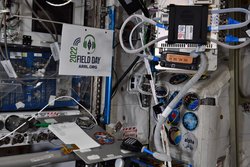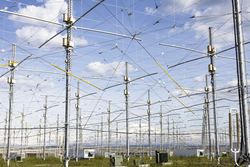 August 18, 2022 John E. Ross, KD8IDJ, Editor
| ||||||
International Space Station Upgrades Amateur Radio Operations ARISS, Amateur Radio on the International Space Station, announced that simultaneous operations of the ARISS voice repeater and digital APRS (Automatic Packet Reporting System) communications on the Space Station are now a reality.
Current ARISS operations include voice repeater transmissions with the JVC Kenwood TM-D710GA in the Columbus module and APRS operation from an identical radio in the Zvezda module. Packet operations are on 145.825 MHz. The Columbus module radio uses the call sign NA1SS and the new radio in Zvezda uses RS0ISS. Aside from the call signs, the radios are identical, and packet operations are the same as before. You can use RS0ISS, ARISS, or APRSAT as the packet path. Both radios are expected to be running full time, except during educational contacts, extra vehicular activities (EVAs), and docking maneuvers. Final checkouts and equipment activation occurred on August 11. ARISS International Chair Frank Bauer, KA3HDO, said, "Simultaneous operation of APRS and the voice repeater on ISS is transformative for ARISS. It represents a key element of our ARISS 2.0 initiative, providing interactive capabilities 24/7 that inspire, engage, and educate youth and lifelong learners -- especially lifelong learning in ham radio operations. Our heartfelt thanks to Sergey Samburov, RV3DR, for making this crucial ARISS 2.0 initiative become a reality." Operational status and expected downtimes of the ISS radios can be found at www.ariss.org/current-status-of-iss-stations.
ARISS is a cooperative venture of international amateur radio societies and space agencies that support the ISS. In the US, sponsors are the Radio Amateur Satellite Corporation (AMSAT), ARRL The National Association for Amateur Radio®, and NASA's Space Communications and Navigation (SCaN) program. The primary goal of ARISS is to promote exploration of science, technology, engineering, arts, and mathematics topics. ARISS does this by organizing scheduled contacts via amateur radio between crew members aboard the ISS and students. Before and during these radio contacts, students, educators, parents, and communities take part in hands-on learning activities tied to space, space technologies, and amateur radio. For more information, see www.ariss.org and www.arrl.org/amateur-radio-on-the-international-space-station. HAARP to Host Open House at Alaska Facility The High-frequency Active Auroral Research Program, (HAARP), will host an open house at the facility in Gakona, Alaska, on August 27, 2022. The event will offer an opportunity to learn how scientists study the Earth's ionosphere and will provide a tour of the research facility. Amateur radio operators who attend can learn about how the ionosphere affects both long- and short-range communications.
The University of Alaska Fairbanks (UAF) acquired HAARP's research equipment from the United States Air Force in August 2015, and their Geophysical Institute operates HAARP under a cooperative research and development agreement. In 2021, the National Science Foundation awarded the UAF Geophysical Institute a 5 - year $9.3 million grant for a new research observatory at HAARP. The Subauroral Geophysical Observatory for Space Physics and Radio Science will explore Earth's upper atmosphere and geospace environment. The facility attracts scientists from universities, government, and the private sector. UAF describes HAARP as "the world's most capable high-power, high-frequency transmitter for study of the ionosphere." Built in three phases, starting in the early 1990s and continuing through 2007, at a cost of some $300 million, the 30-acre facility has 360 transmitters, 180 antennas, and five powerful generators. The open house runs from 9 AM to 3 PM on Saturday, August 27, and, will feature a 90-minute self-guided, tour that will highlight the following:
More information about the HAARP open house is available on their Facebook page. ARRL Welcomes Director of Information Technology ARRL The National Association for Amateur Radio® has announced the hiring of Steve Berry, N1EZ, into the new position of Director of Information Technology. He's from Bedford, New Hampshire, and has been a radio amateur for 45 years. Berry began his 35-year IT career in software development within a wide range of environments, from firmware to Unix device drivers and application development. While working for AT&T Bell Labs (now known as Nokia Bell Labs) as a network consultant, he built his first consulting firm focused on Unix networking and electronic publishing.
After the acquisition of that firm, he worked in senior-level management positions within systems integration and consulting organizations before founding Strafford Technology in 1995. Strafford offered Business Intelligence consulting services and eventually focused on delivering Enterprise Performance Management solutions to Fortune 500 organizations based on Oracle/Hyperion technology. In 2012, Berry and his team built the first Oracle Hyperion-managed application hosting service on the Amazon Web Services platform. Strafford was acquired by Apps Associates in 2020. "I'm pleased to welcome Steve into this new role at ARRL Headquarters," said CEO David Minster, NA2AA. "The position and its responsibilities are key to helping us achieve ARRL's ongoing digital transformation for the benefit of our members." As Director of Information Technology, Berry is responsible for the overall strategic and operational IT functions, including continuous evaluation and execution of processes, systems, applications, and infrastructure. Berry manages a team of professional IT contributors, including a development team and project leaders. Together, they fulfill a variety of technology services for the organization, such as corporate databases and systems, websites and web services, server support, and coordinating outside suppliers of technology services and contracted resources. "I feel truly honored to give back to ARRL and the hobby. Both have done so much for me, especially with the many friends I have made over the years and the ham mentors who gave me a start in my career," said Berry.
Amateur Radio in the News ARRL Public Information Officers, Coordinators, and many other member-volunteers help keep amateur radio and ARRL in the news. "International Space Station: Girl, 8, chats to astronaut on amateur radio." / BBC (United Kingdom), August 17, 2022. -- Thanks to Amateur Radio on the International Space Station (ARISS), and the Hilderstone Radio Society, G0HRS. "State, county honor local amateur radio operators" / WYSH/WQLA Radio (Tennessee), August 17, 2022. -- Thanks to the Tennessee Amateur Radio Emergency Service (TNARES).
ARRL Podcasts Schedule
The latest episode of the ARRL On the Air podcast (Episode 32) addresses the topic of scanning, with specific discussions about memory scanning, CTCSS tone scanning, priority watch, and more. The latest edition of the ARRL Eclectic Tech podcast (Episode 66) features Steve Ford, WB8IMY, discussing VARAC, a new conversational HF digital mode that is gaining popularity, an innovative antenna design that will be traveling on a NASA mission to Europa, and new research exploring the possibility of beaming electric power down to Earth from orbit. The On the Air and Eclectic Tech podcasts are sponsored by Icom. Both podcasts are available on iTunes (iOS) and Stitcher (Android), as well as on Blubrry -- On the Air | Eclectic Tech.
Announcements The Trinidad & Tobago Amateur Radio Society (TTARS) will celebrate Trinidad and Tobago's 60th Anniversary of Independence on August 26 - September 2, 2022. A special event call sign, 9Y60TT, will operate multimode, multiband, and multioperator. Modes will include HF single side band (SSB), CW, Slow Scan TV (SSTV), FT8, JS8, FT4, JT65, 2-meter Earth-moon-Earth (EME), satellite, Automatic Packet Reporting System (APRS) via the International Space Station (ISS), digital voice (DMR, C4FM, D-STAR), EchoLink, and more. QSL is via Logbook of The World (LoTW). For more details on the event, and to obtain a certificate, visit TTARS. ARRL has introduced the third edition of Get On the Air with HF
In Brief... Rice University in Houston, Texas, is offering a new class, "Physics of Ham Radio," beginning on August 22, 2022. The class is primarily aimed at teachers, but Rice undergraduates and post-grads are also welcome. Classes will meet in person, but virtual participation is possible by request. The class teaches the basics of electromagnetic waves, simple circuit and antenna theory, radio propagation, GPS theory and operation, the ionosphere, the magnetosphere, and space weather. The midterm is the Technician class Amateur Radio Service license exam. The second half of the course covers GPS and space weather topics, along with one general electrical circuit lab and safe solar eclipse observation techniques. The class is taught by Professor Patricia Reiff, W5TAR, and will use the fifth edition of The ARRL Ham Radio License Manual. The cost of 3 hours of academic credit is $1,200 (discounted from $8,900) or, for professional development hours only, $150. Some partial scholarships for the academic credit version are available thanks to NASA's HEAT program. For detailed information, visit The Wiess School of Natural Sciences, and for questions, contact Dr. Reiff. The K7RA Solar Update Tad Cook, K7RA, of Seattle, Washington, reports for this week's ARRL Propagation Bulletin: At 2334 UTC on August 17, the Australian Space Forecast Centre issued a geomagnetic disturbance warning.
"Periods of G1 conditions expected during August 19 - 20 due to the combination of coronal hole high -- speed wind stream and several coronal mass ejections observed in the last few days. There is a chance of isolated periods of G2 over August 19 - 20." Local TV newscasts in Seattle noted the possibility of an aurora on Thursday night, although observers would need to travel to dark areas away from the city for any chance of successful viewing. In fact, they recommended using a camera pointed north using a long exposure time. Last week, we noted increasing solar activity, and it continued. Average daily sunspot numbers increased from 65.4 to 95.6, and average daily solar flux increased from 111.9 to 123.7. Predicted solar flux is 125 on August 18 - 19; 120 on August 20; 115 on August 21 - 23; 110 and 95 on August 24 - 25; 94 on August 26 - 27; 96, 98, 100, 108, and 114 on August 28 - September 1; 116 on September 2 - 3; 112 on September 4; 108 on September 5 - 6; 115, 120, 124, and 126 on September 7 - 10; 124 on September 11 - 12; 122, 118, 112, 108, and 102 on September 13 - 17, and 100 on September 18 - 19. Predicted planetary A index is 56 (!), 30, 18, and 8 on August 18 - 21; 5 on August 22 - 26; 12 on August 27; 8 on August 28 - 30; 5 on August 31 - September 2; 24, 28, 18, and 10 on September 3 - 6; 14, 8, 10, and 8 on September 7 - 10; 5, 5, 20, and 15 on September 11 - 14; 12, 12, and 8 on September 15 - 17, and 5 on September 18 - 20. Tamitha Skov says, "Don't worry, this is not a Carrington Event," in an 84-minute video titled, "Incoming Solar Storm Crush." Even Newsweek is reporting it. And of course, British Tabloids and NOAA. Sunspot numbers for August 11 - 17, 2022, were 58, 97, 116, 104, 92, 119, and 83, with a mean of 95.6. The 10.7-centimeter flux was 114.8, 119.5, 124.2, 125.5, 130.6, 128.5, and 122.7, with a mean of 123.7. Estimated planetary A indices were 16, 7, 10, 7, 6, 5, and 31, with a mean of 11.7. Middle latitude A index was 12, 6, 10, 9, 6, 5, and 22, with a mean of 10. Send your tips, questions, or comments to k7ra@arrl.net. A comprehensive K7RA Solar Update is posted Fridays on the ARRL website. For more information concerning radio propagation, visit the ARRL Technical Information Service, read "What the Numbers Mean..." and check out the Propagation Page of Carl Luetzelschwab, K9LA. A propagation bulletin archive is available. For customizable propagation charts, visit the VOACAP Online for Ham Radio website. Share your reports and observations. A weekly, full report is posted on ARRL News.
Just Ahead in Radiosport
Visit the ARRL Contest Calendar for more events and information.
Upcoming Section, State, and Division Conventions
Have News for ARRL? Submissions for the ARRL Letter and ARRL News can be sent to news@arrl.org. -- John E. Ross, KD8IDJ, ARRL News Editor
ARRL -- Your One-Stop Resource for
Subscribe to...
Free of charge to ARRL members...
| ||||||

.jpg)

-2022.jpg)
.jpg)
.jpg)
 Digital, by Steve Ford, WB8IMY. The book, written in an easy-to- understand style, covers how to set up and operate your own HF digital station. Ford includes details for making contacts using 11 different digital modes, including the PACTOR system, the weak-signal WSJT-X modes, VARA, and JS8Call. Join the millions of amateur radio operators worldwide studying propagation with WSPR, contesting with RTTY, and ragchewing with JS8Call.
Digital, by Steve Ford, WB8IMY. The book, written in an easy-to- understand style, covers how to set up and operate your own HF digital station. Ford includes details for making contacts using 11 different digital modes, including the PACTOR system, the weak-signal WSJT-X modes, VARA, and JS8Call. Join the millions of amateur radio operators worldwide studying propagation with WSPR, contesting with RTTY, and ragchewing with JS8Call. 
-Blue.jpg)








